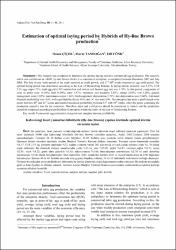Estimation of optimal laying period by hybrids of Hy-line brown production
Citation
ÇİÇEK, H , TANDOĞAN, M , CÖNK, E . (2011). Estimation of optimal laying period by Hybrids of Hy-line Brown production. Ankara Üniversitesi Veteriner Fakültesi Dergisi , 58 (1) , 41-46 . Retrieved from http://vetjournal.ankara.edu.tr/tr/issue/44734/555965Abstract
This research was conducted to determine the optimal laying period in commercial egg production. The research,
which was carried out on 34900 Hy-line Brown chicks in a commercial enterprise, is completed between December 2002 and July
2004. The first twenty week period of the study occurred as chick growth, and 21st-80th weeks occurred as egg yield period. The
optimal laying period was determined according to the Law of Diminishing Returns. In laying period, mortality was 8.17%; FCR
2.55; egg output 72%; total egg yield 302 number/hen and broken and fissured egg rate was 1.70%. In this period, components of
costs as pullet were 15.16%; feed 58.50%; labor 1.87%; veterinary and medicine 2.31%; energy 2.01%; viol 4.22%; general
management costs 1.83%; maintenance-repair 1.66%; built-equipment depreciation 2.78%; hen depreciation were 9.66%. Estimated
financial profitability was -0.01, with a profitability factor -0.01, and O/I rate were 0.96. The enterprise has made a profit (break-even
point) between 40th and 41st weeks and reached maximum profitability between 54th with 55th weeks. After this point, continuing the
production caused a loss for the enterprise. Therefore, input and yield prices should be considered in market and the production
should be completed according to profitability of enterprise within the limits of the Law of Diminishing Returns.
Key words: Commercial egg production, marginal cost, marginal income, profitability Bu araştırma, ticari yumurta tavukçuluğunda optimal üretim süresinin tespit edilmesi amacıyla yapılmıştır. Özel bir
ticari işletmede 34900 adet kahverengi hibritlerle (Hy-line Brown) yürütülen araştırma, Aralık 2002-Temmuz 2004 arasında
tamamlanmıştır. Üretimin ilk 20 haftası civciv büyütme, 21-80. haftalar arası yumurta verim dönemi olarak gerçekleşmiştir.
Optimum üretim süresinin tayininde Azalan Marjinal Verimler Kanunu dikkate alınmıştır. Yumurta verim döneminde mortalite
%8.17; FCR 2.55 kg, yumurta randımanı %72, toplam yumurta verimi 302 adet/tavuk ve kırık-çatlak yumurta oranı %1.70 olarak
tespit edilmiştir. Bu dönemde maliyet unsurlarından yarka %15.16; yem %58.50; işçilik %1.87; veteriner-sağlık %2.31; enerji
%2.01; viyol %4.22; genel idare giderleri %1.83; bakım-onarım %1.66; bina-ekipman amortismanı %2.78 ve canlı demirbaş
amortismanı %9.66 olarak hesaplanmıştır. Mali rantabilite -0.01, rantabilite faktörü -0.01 ve masraf hasıla oranı da 0.96 değerinde
bulunmuştur. İşletme 40 ile 41. haftalar arasında kara geçmiş (başabaş noktası), 54 ile 55. haftalarda maksimum karlılığa ulaşmıştır.
Üretimin bu noktadan sonra sürdürülmesi işletmenin bu üretim dönemini zararla kapatmasına neden olmuştur. Bu nedenle piyasadaki
girdi ve ürün fiyatları da dikkate alınarak, üretimin Azalan Marjinal Verimler Kanunu çerçevesinde sonlandırılması işletme karlılığı
açısından oldukça önemlidir
Source
Ankara Üniversitesi Veterinerlik DergisiVolume
58Issue
1URI
http://vetjournal.ankara.edu.tr/tr/download/article-file/698561https://hdl.handle.net/11630/7661



















